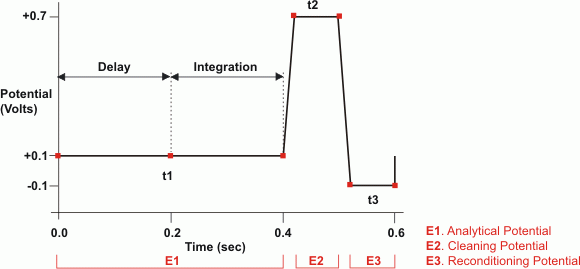
Integrated Amperometry Mode
In addition to the DC Amperometry Mode, Dionex electrochemical detectors can be operated in integrated amperometry mode. Integrated amperometry is similar to DC amperometry in that electroactive analytes are oxidized or reduced at the surface of an electrode. However, instead of a constant potential being applied, a series of potential changes is repeated over time. By repeatedly pulsing between high positive and negative potentials, the electrode surface is continually cleaned and regenerated. Current is measured by integration during a portion of the repeating potential vs. time Waveform.
In integrated amperometric detection (also known as IA or IPAD), current is integrated at two or more potentials. Pulsed amperometric detection (also known as PAD) is similar to integrated amperometry. However, in PAD, current is integrated at a single potential.
When the Dionex ED and ED40/50/50A electrochemical detectors are operated in integrated amperometry mode, they can perform either IPAD or PAD. The applied waveform determines which technique is used.
Example IPAD Waveform
In the example integrated amperometry waveform shown below, the current is integrated at two potentials: first, while the potential is swept across the metal oxide formation wave, and then again during the reverse sweep across the oxide reduction wave. Without the presence of analyte molecules, the net charge is around zero. Positive and negative cleaning pulses are added to the waveform following the Integration Interval.

Example PAD Waveform
During a PAD waveform, the current is integrated at only one potential as shown in the example waveform below. The potentials, labeled E1, E2, and E3, are applied for durations t1, t2, and t3, respectively. At t1, the E1 potential is applied. After a delay, the signal is measured by integrating the current for a fixed time. At t2 and t3, positive and negative cleaning pulses are added to the waveform.
